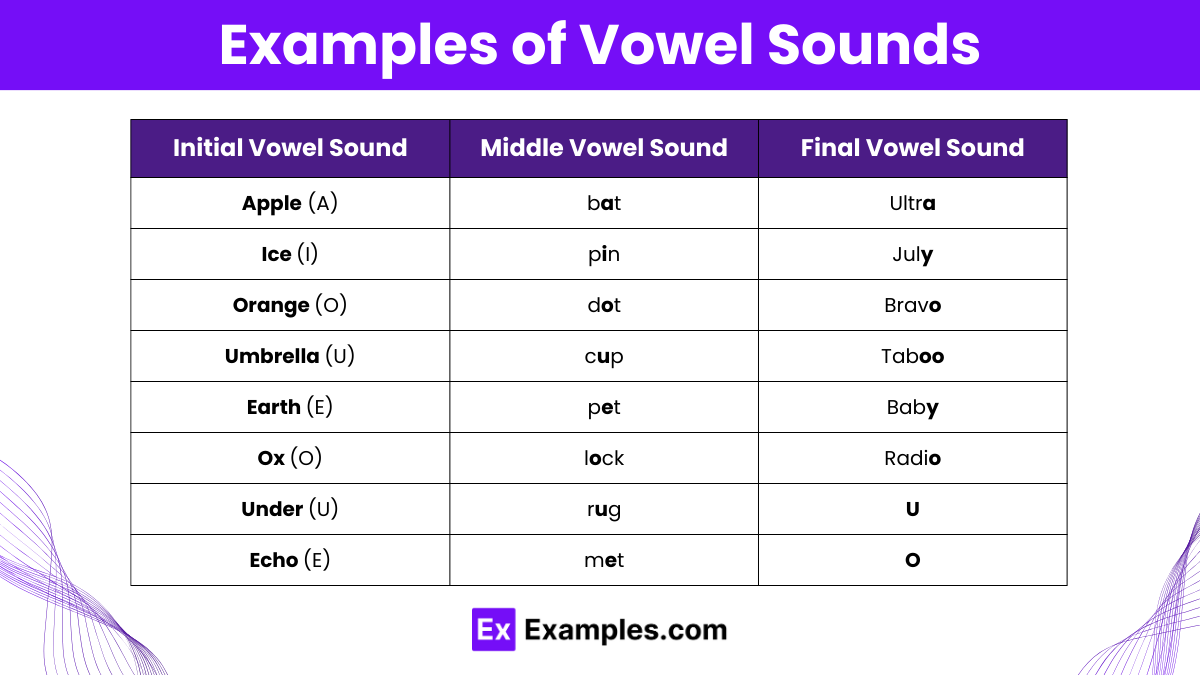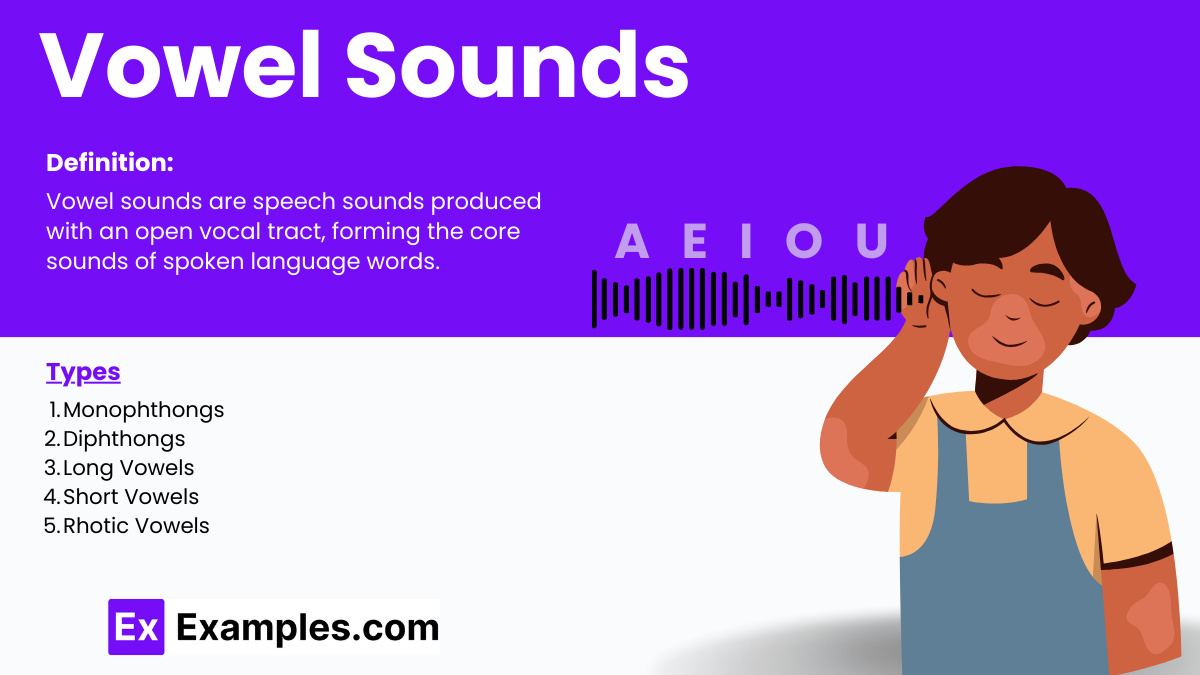40+ Vowel Sounds Examples
Vowel sounds are the building blocks of speech, forming the core of every word we utter. They are produced with an open vocal tract, allowing air to flow freely. English has five primary vowel sounds: A, E, I, O, and U. Each vowel can be pronounced differently depending on context and accent, creating a diverse range of sounds essential for effective communication and language comprehension. Understanding vowel sounds is fundamental to mastering pronunciation and fluency in any language.
What is Vowel Sound?
Vowel sounds are the foundational elements of speech, comprising the sounds produced with an open vocal tract. English features five primary vowels: A, E, I, O, and U, each with various pronunciations influenced by context and accent. Understanding vowel sounds is crucial for mastering pronunciation and fluency in any language.
How to identify Vowel Sounds?
Understanding how to identify vowel sounds is fundamental for improving pronunciation and language comprehension. Here are five key strategies:
- Open Vocal Tract: Vowel sounds are characterized by an open vocal tract, where the mouth remains unobstructed, allowing air to flow freely from the lungs.
- Five Primary Vowels: In English, there are five primary vowel sounds represented by the letters A, E, I, O, and U. These vowels serve as the building blocks of words and can have multiple pronunciations depending on the context and accent.
- Varied Pronunciations: Vowel sounds can vary significantly in pronunciation based on factors such as regional accents, surrounding consonants, and word stress. For example, the vowel sound in the word “cat” may differ slightly from its pronunciation in “caterpillar.”
- Listening Practice: Developing the ability to distinguish between different vowel sounds requires regular listening practice. Listening to native speakers, a recordings, or language learning resources can help train your ear to recognize subtle differences in pronunciation.
- Phonetic Resources: Utilizing phonetic guides and resources, such as the International Phonetic Alphabet (IPA), can provide a visual representation of vowel sounds and their corresponding symbols. Learning to associate these symbols with their respective sounds can aid in accurately reproducing vowel sounds in speech.
Types of Vowel Sounds
Understanding the nuances of vowel sounds is essential for effective communication. Here’s a detailed exploration of the various types:
- Monophthongs:
- These are single, stable vowel sounds.
- No change in quality during pronunciation.
- Examples: “ah” in “father,” “ee” in “see.”
- Diphthongs:
- Diphthongs consist of two vowel sounds blended together within the same syllable.
- Smooth transition between sounds.
- Examples: “oi” in “coin,” “ou” in “cloud.”
- Long Vowels:
- Pronounced with extended duration.
- Often have a distinct quality compared to short vowels.
- Examples: “ee” in “meet,” “o” in “go.”
- Short Vowels:
- Pronounced with shorter duration.
- Different quality from long vowels.
- Examples: “a” in “cat,” “i” in “sit.”
- Rhotic Vowels:
- Influenced by the presence of “r” in the syllable.
- Result in a unique pronunciation.
- Examples: “ar” in “car,” “or” in “fork.”
Vowel Sounds list
Understanding vowel sounds is key to mastering pronunciation. Here’s a comprehensive list along with explanations:
- /ɪ/ as in “sit”: This is a short, lax vowel sound produced with the tongue in a neutral position.
- /iː/ as in “see”: This is a long vowel sound produced with the tongue high and front in the mouth.
- /e/ as in “met”: This is a mid-front vowel sound produced with the tongue in a mid position.
- /æ/ as in “cat”: This is a short, open vowel sound produced with the tongue low and front in the mouth.
- /ɑː/ as in “father”: This is a long, open vowel sound produced with the tongue low and back in the mouth.
- /ʌ/ as in “cup”: This is a mid-open vowel sound produced with the tongue in a central position.
- /ʊ/ as in “book”: This is a short, lax vowel sound produced with the tongue in a central position.
- /ɔː/ as in “four”: This is a long, mid-open vowel sound produced with the tongue low-mid and back in the mouth.
- /ɝ/ as in “her”: This is a rhotic vowel sound produced with the tongue in a central position and the lips slightly rounded.
- /ə/ as in “sofa”: This is a mid-central vowel sound produced with the tongue in a neutral position and is often referred to as the “schwa.”
Vowel Sounds in Phonetics
Here are the vowel sounds in phonetics represented by International Phonetic Alphabet (IPA) symbols:
| Vowel Sound | IPA Symbol | Example Word |
|---|---|---|
| /iː/ | “ee” | see |
| /ɪ/ | “ih” | sit |
| /eɪ/ | “ay” | say |
| /ɛ/ | “eh” | bed |
| /æ/ | “a” | cat |
| /ʌ/ | “uh” | cup |
| /ɑː/ | “ah” | father |
| /ɔː/ | “aw” | saw |
| /oʊ/ | “oh” | go |
| /ʊ/ | “oo” | book |
| /uː/ | “oo” | blue |
| /aɪ/ | “eye” | high |
| /aʊ/ | “ow” | now |
| /ɔɪ/ | “oy” | boy |
| /ɪə/ | “eer” | here |
| /eə/ | “air” | care |
| /ʊə/ | “oor” | pure |
| /ə/ | “uh” | sofa |
Vowel Sounds Words
| Vowel Sound | Example Words |
|---|---|
| /iː/ (ee sound) | see, tree, me, eat |
| /ɪ/ (ih sound) | sit, hit, bit, lid |
| /eɪ/ (ay sound) | say, day, play, rain |
| /ɛ/ (eh sound) | bed, red, men, pet |
| /æ/ (a sound) | cat, hat, bat, black |
| /ʌ/ (uh sound) | cup, sun, run, luck |
| /ɑː/ (ah sound) | father, car, star, far |
| /ɔː/ (aw sound) | saw, law, paw, door |
| /oʊ/ (oh sound) | go, no, boat, so |
| /ʊ/ (oo sound) | book, look, put, good |
Initial Vowel Sounds Examples

An initial vowel sound refers to the first sound produced in a word, which is a vowel. It’s the sound you hear when you pronounce the first letter or letters of a word. Understanding initial vowel sounds is crucial for accurate pronunciation and word recognition. In English, words can start with various vowel sounds, each contributing to the overall phonetic makeup of the word. Recognizing and mastering initial vowel sounds is essential for effective communication and language fluency.
Here are some examples of words starting with initial vowel sounds:
- /iː/ (ee sound):
- eat
- eagle
- ink
- equal
- /ɪ/ (ih sound):
- it
- igloo
- insect
- iguana
- /eɪ/ (ay sound):
- eight
- egg
- ear
- ape
- /ɛ/ (eh sound):
- eat
- eggplant
- elephant
- end
- /æ/ (a sound):
- apple
- ant
- ask
- apricot
- /ʌ/ (uh sound):
- up
- umbrella
- under
- uncle
- /ɑː/ (ah sound):
- apple
- alligator
- antelope
- arm
- /ɔː/ (aw sound):
- orange
- ostrich
- octopus
- olive
- /oʊ/ (oh sound):
- open
- ocean
- oat
- oak
- /ʊ/ (oo sound):
- up
- umbrella
- under
- uncle
Medial Vowel Sounds Examples
A medial vowel sound refers to a vowel sound that occurs in the middle of a word, between consonants. It’s the sound you hear when you pronounce a vowel that is neither at the beginning nor at the end of a word. Understanding medial vowel sounds is important for accurate pronunciation and comprehension of words in spoken language. In English, words can contain various medial vowel sounds, each contributing to the overall phonetic structure of the word. Recognizing and mastering medial vowel sounds aids in effective communication and language fluency.
Here are examples of words with medial (middle) vowel sounds:
- /iː/ (ee sound):
- believe
- receive
- ceiling
- field
- /ɪ/ (ih sound):
- middle
- little
- nickel
- kitten
- /eɪ/ (ay sound):
- today
- survey
- delay
- okay
- /ɛ/ (eh sound):
- melody
- yellow
- fellow
- lemon
- /æ/ (a sound):
- animal
- cabin
- fabric
- captain
- /ʌ/ (uh sound):
- button
- sudden
- mutton
- custom
- /ɑː/ (ah sound):
- drama
- comma
- llama
- pajama
- /ɔː/ (aw sound):
- chocolate
- sofa
- postal
- vocal
- /oʊ/ (oh sound):
- total
- remote
- hero
- potato
- /ʊ/ (oo sound):
- sugar
- assume
- pursue
- refuse
Final Vowel Sounds Examples
A final vowel sound refers to a vowel sound that occurs at the end of a word. It’s the sound you hear when pronouncing the last vowel in a word. Understanding final vowel sounds is crucial for accurate pronunciation and word recognition. In English, words can end with various vowel sounds, each contributing to the overall phonetic makeup of the word. Recognizing and mastering final vowel sounds aids in effective communication and language fluency.
Here are examples of words with final (ending) vowel sounds:
- /iː/ (ee sound):
- happy
- sunny
- bunny
- candy
- /ɪ/ (ih sound):
- happy
- bunny
- candy
- pony
- /eɪ/ (ay sound):
- they
- play
- stay
- okay
- /ɛ/ (eh sound):
- bed
- red
- fed
- led
- /æ/ (a sound):
- cat
- hat
- mat
- bat
- /ʌ/ (uh sound):
- cup
- up
- pup
- luck
- /ɑː/ (ah sound):
- car
- star
- far
- jar
- /ɔː/ (aw sound):
- saw
- raw
- paw
- straw
- /oʊ/ (oh sound):
- go
- no
- hello
- ago
- /ʊ/ (oo sound):
- glue
- true
- blue
- you
How to Produce Vowel Sounds?
To produce vowel sounds, open your mouth to allow air to flow freely while shaping your tongue and lips according to the specific sound. Vowels are created without significant obstruction in the vocal tract. Practice pronunciation for clarity.
How do you teach Vowel Sounds?
Teaching vowel sounds involves auditory and visual aids, emphasizing mouth and tongue positions, and practicing through repetition. Incorporate interactive activities, such as games and songs, to engage learners. Provide feedback and encouragement to reinforce correct pronunciation.
How many are Vowel Sounds?
There are typically around 14 to 20 vowel sounds in English, including long and short vowels, diphthongs, and schwa. The exact number may vary depending on regional accents and dialects. Each vowel sound plays a distinct role in pronunciation.



